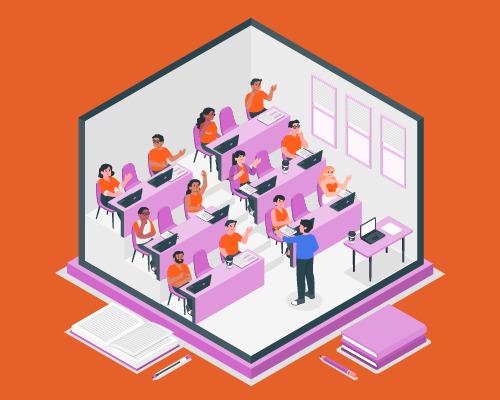How Asynchronous Learning Can Transform Your Educational Experience

Asynchronous learning is a flexible way to learn where you set your own pace. It’s also called self-paced training and offers freedom and convenience.
This is different from traditional classrooms where everyone learns at the same time. Examples of asynchronous learning include online courses, video lectures, discussion boards, and self-paced lessons.
It’s very personalised and convenient, making it easy for students to balance their learning with other responsibilities. However, it can also be isolating and requires self-discipline.
In this blog, we’ll explore what asynchronous learning is in detail, including its characteristics, advantages, and disadvantages. We’ll also discuss how it can improve your educational offerings.
What Is Asynchronous Learning?
Asynchronous classes give students the freedom to learn at their own pace. While there are usually deadlines, students can access materials, talk to others, and connect with their teachers on their own schedule, often over a longer period of time. Teachers might suggest an order for the materials, but students can often decide how much time they spend on each part.
Asynchronous online classes use online discussions and shared files to keep everyone connected. They also include self-guided lessons and workshops. Many students find asynchronous learning more comfortable for certain subjects, even though they might be expected to participate more actively in this format than in others.
Characteristics Of Asynchronous Learning
Here’s a closer look at the characteristics that make asynchronous learning unique:
-
Interaction Mode
Interactions are a crucial part of asynchronous learning. Even though they don’t involve in-person meetings, it still creates a connection. Asynchronous learning uses tools like online forums, discussion boards, email, and messaging apps to help learners and teachers communicate. These tools make learning more flexible and personal. You can learn at your own speed, ask questions whenever you want, and talk with your classmates. This kind of interaction can build a sense of community and support, even though it happens outside of regular class time.
-
Flexibility
Flexibility is the main reason why people prefer asynchronous learning. Unlike traditional classrooms with fixed schedules, asynchronous learning allows you to set your own pace and study at a time that suits your lifestyle. Whether you’re a working professional juggling multiple responsibilities, a student with extracurricular activities, or someone who simply prefers a more flexible learning environment, asynchronous courses offer the freedom to learn on your terms. This flexibility can be particularly beneficial for those who find it difficult to commit to fixed schedules or who need to balance their education with other commitments.
-
Learner Engagement
Asynchronous learning, while offering flexibility, can sometimes find it challenging to keep learners as engaged as in a traditional classroom. However, with the right approaches, learners can stay actively involved. One important factor is well-organised content. Breaking down information into smaller, easier-to-understand parts with clear goals helps learners stay focused. Also, interactive activities like quizzes, discussions, and simulations can make learning more interesting.
Regular feedback from your teacher is important too. Getting timely responses and personalised feedback can motivate you and make you feel valued. Finally, creating a sense of community can help with engagement. Online forums, group projects, and virtual meetups can help learners connect with others and share their experiences, making learning more enjoyable and collaborative.
-
Promotes Self-Paced Deep Learning
As mentioned earlier, asynchronous learning gives you the freedom to explore learning topics at your own speed. This flexibility lets you dive deeper into what interests you or take your time with challenging concepts. Unlike traditional classrooms where you might feel pressured to keep up, asynchronous learning lets you spend as much time as you need to fully understand complex ideas. This self-directed approach can lead to a deeper and more meaningful understanding of the subject matter.
Advantages Of Asynchronous Learning
Asynchronous learning gives you several advantages such as:
-
Freedom to Train and Teach Multiple People at Once
Creating asynchronous e-learning content, like online courses, is a great way to teach a large number of people. Massive Open Online Courses (MOOCs) are a perfect example of this. These courses are designed to reach an unlimited number of learners and can be accessed by anyone online.
MOOCs have attracted a huge number of participants. Schools and companies can create their own courses and deliver them to a wide range of learners without having to schedule individual sessions or require instructors to be present at a specific time or place.
-
Flexibility in Learning
Asynchronous e-learning allows learners to complete their asynchronous e-learning activities on their own schedule, from anywhere in the world, using any device. This convenience is a major advantage.
In addition, online courses allow you to deliver essential training without the obstacles that arise from a traditional learning system. This flexibility has been a main factor in the growth of adult education and continued professional education. Learners can watch a video on their phone during their commute and participate in a lively discussion forum about specific learning topics.
-
Reinforcing Learning
Asynchronous e-learning courses can be used to reinforce previously covered topics. These courses offer you the flexibility of sending review videos via email to recap course materials from earlier lessons. In addition, you can use a discussion forum to allow learners to ask questions and receive personalized answers. Online courses can also help learners explore topics in more depth as a supplement to their instructor-led classes.
-
More Learner Control (Can be removed similar to info mentioned above)
Asynchronous learning is known as a learner-focused approach. It allows students and employees the freedom to manage their learning on their own schedule. They can watch videos, read materials, participate in discussion forums, complete assignments, and take tests whenever it suits them. This flexibility lets learners set their own pace and decide when to engage with the content. For working adults, this control is often what makes continuing education possible.
-
Flexible Assessment Formats
Asynchronous e-learning also offers more flexibility in assessment formats. One example is the growing use of electronic student portfolios. An e-student portfolio is a collection of student work that demonstrates their understanding of a particular skill or topic. These portfolios often include a variety of materials, such as videos, essays, presentations, audio, and more, to showcase a student’s comprehensive knowledge. Instructors can then assess and grade the portfolios based on specific criteria. This form of assessment works well in asynchronous e-learning environments because it gives students the freedom to develop their knowledge over time.
Disadvantages of Asynchronous Learning
-
Lack of Immediate Feedback
Students might experience delays in getting answers to their questions or receiving feedback on their assignments. This can slow down their learning and lead to frustration.
-
Less Social Interaction
Watching recorded sessions can make students feel less connected to their instructor, and not seeing their classmates might make them feel less engaged with the course overall.
-
Lack of Self-Discipline
Online learning demands a lot of self-discipline and motivation, which some students may find challenging. Without strict deadlines, students might delay watching recorded sessions, thinking they can “get to it later.”
-
Technology Dependence
This learning method relies heavily on technology and internet access. Issues like poor connectivity or limited access to devices can make it difficult for students to participate effectively.
How Extramarks Enhances the Asynchronous Learning Experience
Extramarks can greatly improve asynchronous learning, providing a flexible and self-paced educational setting. Here are some ways Extramarks supports asynchronous learning:
-
Accessible Learning Materials
The Extramarks Learning App offers students a wide range of educational resources that can be accessed anytime and anywhere. Students can download lessons, videos, and quizzes to study at their own pace, fitting their individual learning styles and schedules.
-
Self-Paced Learning
Extramarks offers a vast library of pre-recorded video lessons on various subjects. This allows students to learn at their own pace, pausing and rewinding content as needed for a deeper understanding.
-
Accessibility
The Extramarks Learning App provides students with 24/7 access to a wealth of educational resources. They can personalise their studies by selecting and exploring specific topics, chapters, and subjects. Plus, the 24/7 help desk ensures that technical support and guidance are always available, assisting students in overcoming any learning challenges.
Closing Thoughts
Asynchronous learning offers a flexible and personalised approach to education, making it easier for students to balance their studies with other commitments. While it requires self-discipline, it opens up opportunities for deeper learning at one’s own pace. This method has its challenges, but with the right tools and strategies, it can be a highly effective way to learn.
Last Updated on February 17, 2025
Reviewed by

Prachi Singh | VP - Academics
Prachi Singh is a highly accomplished educationist with over 16 years of experience in the EdTech industry. Currently, she plays a pivotal role at Extramarks, leading content strategy and curriculum development initiatives that shape the future of education...read more.










